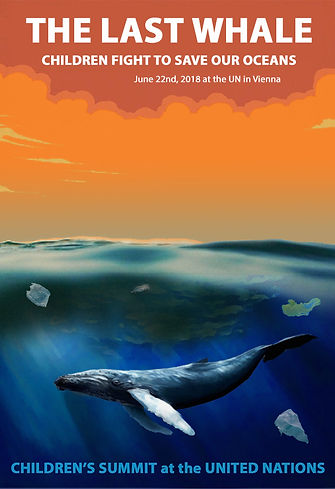It Began with Ocean Plastic Pollution
Over 5 trillion pieces of plastic fill our oceans. 269,000 tons floats along the surface, while four billion plastic microfibers/km2 litter the deep sea. The decimation to wildlife and food webs is unfathomable. In the past two decades alone, billions of pounds have accumulated in our seas, each piece of which will break down into tinier and tinier pieces, releasing toxins and being mistaken for food for hundreds of years. In another 20 years, what will our oceans look like? A frightening question.
Children are horrified by this reality. And the 12 year olds at our school and their art teacher, Peder Hill, decided to bring attention to this tragic problem by building a 5-meter-long humpback whale sculpture made from the same trash that desecrates our planet’s life and beauty.
Children's Clean Ocean Summit at the UN
But we felt it wasn't enough, so we organized the Children’s Clean Ocean Summit at the United Nations in Vienna (titled The Last Whale) so they could decide for themselves what must be done and share their perspectives with the world. They were joined on June 22nd, 2018, by hundreds of children representing dozens of cultures, in alliance with each other and the UN in taking a firm stand against ocean pollution. The children also installed their sculpture at the UN for the week that included World Environment Day and World Oceans Day to fulfil its purpose. See photos
And their voices echoed across the world
The Summit was recognised in articles in 8 languages and by including Kings, Presidents, Princes, a Queen (Elisabeth), Prime Ministers, and even a Knight (Sir Attenborough). The Clean Ocean Declaration was sent to all world leaders, of whom 20 have so far personally responded - in addition to many letters from ministers and such. The Declaration was written by the kids and included their prioritised list of what they feel should be done and the signatures of every child who attended the summit.
Our work has also been included in two books so far.
The Project's Massive Growth
We deeply believe that giving children an actual voice in the world is vital to humanity’s future. And it turns out we definitely weren’t the only ones. To run a massive summit with just a teacher and a handful of scrappy passionate kids wouldn’t have been possible, so we turned to the global platform VolunteerMatch, and very quickly wonderful people from around the world joined me with the goal of empowering kids to not just learn about plastic ocean pollution, but DO something.
Hundreds of volunteers have come forward, including six app developers who are coding my Fatechanger app, an education and lobbying app designed to give kids a voice. Though unfinished, the app has already been taken up by the German Federal Ministry in its Ocean Plastics Lab international traveling exhibition, which showcases the contribution of science to understand and tackle the problem of plastics in the ocean.
The plastic trash whale sculpture was also exhibited in May, 2018 in the Austrian Academy of Sciences to enormous success. In the second half of 2021 it will be installed for well over a year in Vienna's Haus des Meeres, Austria's largest aquarium. See pictures here.
The Bigger Picture
Kids need a voice about not just plastic pollution, but also climate change, the circular economy and sustainability. Our app includes powerful tools to both educate youth about these issues and empower them to change local and global environmental policy. They may be the help we obviously so desperately need. We're currently in the process of developing the Kids Save Ocean NGO to bring our initiatives to scale.




